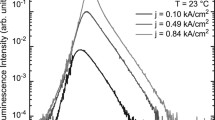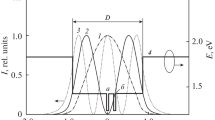Abstract
We report the growth, fabrication and characterization of GaInN/GaN multi-quantum well lasers grown on (00.1) sapphire substrates by low pressure metalorganic chemical vapor deposition. The threshold current density of a 1800 µm long cavity length laser was 1.4 kA/cm2 with a threshold voltage of 25 V. These lasers exhibited series resistances of 13 and 14 Ω at 300 and 79 K, respectively.
Similar content being viewed by others
1 Introduction
Semiconductor laser diodes (LDs) and light emitting diodes (LEDs) emitting in the ultraviolet-to-visible spectral region are important sources of light for practical applications. Of particular importance is the use of short wavelength (λ~400 nm) laser diodes for the optical data storage (compact disk, digital video disk), printing and imaging industry. At present, only a few research groups have reported III-V nitride based laser diodes. [1] [2] [3] [4] [5] [6] In this paper, we report the growth, fabrication and characterization of GaInN/GaN multi-quantum well laser diodes emitting at 405 nm.
2 GalnN/GaN multi-quantum wells
The epitaxial layers were grown on (00.1) sapphire substrates by low pressure metalorganic chemical vapor deposition (LP-MOCVD). Details of the growth conditions may be found in Ref. [7]. Figure 1 shows the room temperature photoluminescence and optical pumping from a 10 period 33Å Ga0.89In0.11N/66Å GaN multiple quantum well (MQW) structure capped with a thin GaN layer. The photoluminescence measurements were conducted using a 10 mW He-Cd laser. The optical pumping was carried out using a pulsed nitrogen laser (337 nm) with a pulse width of 600 ps and a repetition rate of 6 Hz. Neutral density filters were used to attenuate the optical power. Stimulated emission was collected from a bar with mechanically polished edges and was observed for pumping densities higher than a threshold estimated at 100 kW/cm2. The peak position was 401 nm and its width of ~1 nm was limited by the resolution of the measurement equipment.
3 GaInN/GaN multi-quantum well lasers
Figure 2(a) shows a schematic diagram of the laser diodes grown under the same conditions as discussed in the previous section, which consisted of (i) a 3 µm-thick Si-doped GaN (n~ 2×1018 cm−3); (ii) a 10 period 33 Å Ga0.89In0.11N/66 Å GaN multiple quantum wells; and (iii) a 0.25 µm-thick Mg-doped GaN contact layer (p~2×1017cm−3). The wafers were then annealed using rapid thermal annealing (RTA) under nitrogen ambient for 30 seconds at 1000° C to achieve low resistivity p-type GaN:Mg [8], and broad-area lasers with 100-µm wide stripes were fabricated using ECR-RF dry etching. In order to make the n-type contact, the surface of the sample was etched until the underlying n-type GaN layer was exposed as shown in Figure 2(b). Ti/Au and Ni/Au metal contacts were deposited on the n-type and p-type GaN, respectively, using an electron-beam evaporator and were defined by a conventional lift-off process. Mirror facets were mechanically polished for various cavity lengths from 700 µm to 1800 µm. The roughness of the facet surface was in the range of 50 nm. No antireflection or high-reflection coatings were applied on the mirror facets.
Figure 3 shows the room temperature electroluminescence spectrum for increasing injected currents under continuous wave operation. The light was collected from the back of the sample. An intense electroluminescence peak at ~416nm could be observed.
Figure 4(a) shows the 79 K photoluminescence of the MQW laser structure. In order to be able to detect photoluminescence from the multi-quantum wells in the laser structures, the top p-type GaN:Mg layer was partially removed by dry etching to allow penetration of the laser beam. The spectrum exhibited a small peak at ~384 nm and an intense peak at 410 nm. The full width at half maximum of the peak at 410 nm is ~11 nm. This width and the presence of two peaks in the spectrum strongly suggests that there is some degree of phase separation in the MQW structure, leading to localized regions -e.g. quantum dots- which are In rich and others regions which are In deficient. Figure 4(b) shows the 79 K electroluminescence spectrum of this laser structure, exhibiting a peak at ~403 nm.
Laser diodes with cavity lengths varying from 700 to 1800 µm were prepared and bonded with indium to copper heatsinks. Light-current characteristics were recorded in pulse operation (pulse width 2–6 µs, repetition rate 200 Hz) using a silicon detector. From the current versus voltage (I-V) curve, the series resistance of the laser (L~ 1800µm) was estimated to be 13 Ω at 300 K (turn-on voltage ~ 3.6V) and 14 Ω (turn on voltage ~ 6V) at 79 K, as shown in Figure 5. When decreasing the sample temperature from 300 to 79 K, the resistivity of the p-type GaN:Mg is expected to increase drastically, by at least two orders of magnitude, as a result of the relatively high activation energy of Mg levels in GaN. [9] [10] The fact that the series resistance does not increase significantly in these diodes may be directly due to the small thickness of the GaN:Mg layer, to the absence of AlGaN cladding layers or to higher p-type doping of GaN:Mg which results in lower device resistances. [10]
Output power versus injection current for a MQW GaInN/GaN 405 nm uncoated diode laser measured at 79 K (pulse operation: 5 µs-200 Hz) with cavity length of 1800 µm and 100 µm-wide aperture. Inset: Current-voltage characteristics of the laser diode with series resistance of 13 Ω at 300 K and 14 Ω at 79 K. Spectrum of the laser diode slightly above threshold.
Figure 5 illustrates the light output power versus injection current of an uncoated 1800 µm-long laser at 79 K. Stimulated emission was observed at currents of 2.5 A, which corresponds to a threshold current density of 1.4 kA/cm2. Because the laser stripes used in this study are 100 µm wide, the lasing action may occur in a filament and the threshold current density may be locally higher than the value measured above. The voltage of this laser at threshold was 25 V. The peak wavelength of the measured lasers was 405 nm at 3.4 A as shown in Figure 5. At currents lower than 4 A, no degradation was observed for these diodes under pulse operation.
Table 1 summarizes the emission wavelengths from the same laser wafer measured at low temperature (79 K) by photoluminescence, electroluminescence and current injection stimulated emission. A good agreement between the electroluminescence and current injection stimulated emission is observed.
The threshold current density for several lasers of different cavity length was measured and the results are summarized in Figure 6. Further measurements of these laser diodes are in progress. Improvements in the performance of these MQW devices are also in progress.
4 Conclusion
In conclusion, GaInN/GaN multi-quantum well lasers were grown on basal plane sapphire substrates by low pressure MOCVD and characterized. Preliminary studies for these devices showed laser operation at 405 nm with a threshold current density of 1.4 kA/cm2 and a threshold voltage of 25 V; series resistance was 13 Ω at 300 K and 14 Ω at 79 K.
References
S. Nakamura, M. Senoh, S. I. Nagahama, N. Iwasa, T. Yamada, T. Matsushita, Y. Sugimoto, H. Kiyoku, Jpn. J. Appl. Phys. 36, L1059 (1997).
I. Akasaki, S. Sota, H. Sakai, T. Tanaka, M. Koike, H. Amano, Electron. Lett. 32, 1105–1106 (1996).
K. Itaya, M. Onomura, J. Nishio, L. Sugiura, S. Saito, M. Suzuki, J. Rennie, S. Nunoue, M. Yamamato, H. Fujimoto, Y. Kokobun, Y. Ohba, G. Hatakoshi, M. Ishikawa, Jpn. J. Appl. Phys. 35, 11315–11317 (1996).
A Kuramata, K Domen, R Soejima, K Horino, S Kubota, T Tanahashi, Jpn. J. Appl. Phys. 36, L1130 (1997).
G.E. Bulman, K. Doverspike, S.T. Sheppard, T.W. Weeks, H.S. Kong, H.M. Dieringer, J.A. Edmond, J.D. Brown, J.T. Swindell, J.F. Schetzina, Electron. Lett. 33, 1556–1557 (1997).
M.P. Mack, A. Abare, M. Aizcorbe, Peter Kozodoy, S. Keller, U. K. Mishra, L. Coldren, Steven DenBaars, MRS Internet J. Nitride Semicond. Res. 2, 41 (1997).
A. Saxler, D. Walker, P. Kung, X. Zhang, M. Razeghi, J. Solomon, W. C. Mitchel, H. R. Vydyanath, Appl. Phys. Lett. 71, 3272 (1997).
S. Nakamura, T. Mukai, M. Senoh, N. Iwasa, Jpn. J. Appl. Phys. 31, L139–L142 (1992).
H. Nakayama, P. Hacke, M. R. H. Khan, T. Detchprohm, K. Hiramatsu, N. Sawaki, Jpn. J. Appl. Phys. 35, L282 (1996).
P. Kung, A. Saxler, D. Walker, X. Zhang, R. Lavado, K.S. Kim, M. Razeghi, Mater. Res. Soc. Symp. Proc. 449, 79–84 (1997).
Acknowledgments
The authors would like to acknowledge the permanent support of M. Yoder, Dr. Y.-S.-Park, and Dr. C. Wood from ONR; Dr. L. Lome from BMDO; Dr. A. Husain from DARPA; and Dr. M. Prairie, Dr. G. Witt, Dr. W. Mitchel and Dr. G. Brown from the Air Force. This work was supported by BMDO/ONR contract No. N00014-93-1-0235, and DARPA/ONR contract No. N00014-96-1-0714.
Author information
Authors and Affiliations
Rights and permissions
About this article
Cite this article
Kung, P., Saxler, A., Walker, D. et al. GaInN/GaN Multi-Quantum Well Laser Diodes Grown by Low-Pressure Metalorganic Chemical Vapor Deposition. MRS Internet Journal of Nitride Semiconductor Research 3, 1 (1998). https://doi.org/10.1557/S1092578300000739
Received:
Accepted:
Published:
DOI: https://doi.org/10.1557/S1092578300000739











